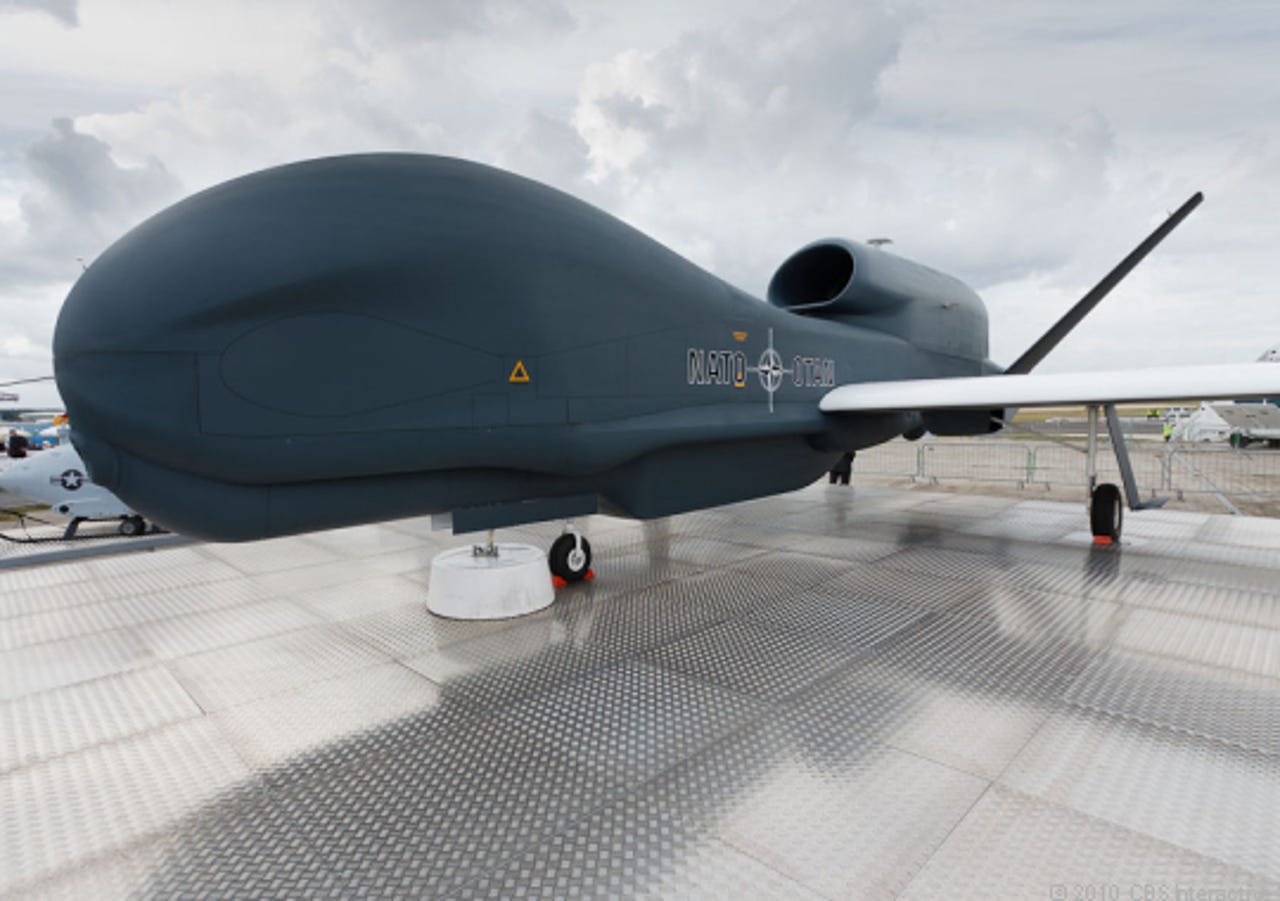Photos: Farnborough air show demos the planes that fly without pilots


Unmanned aerial vehicles on display
Most trade shows will fit inside any old convention center big enough to accommodate the vendor booths, sales reps, and keynote speeches. But the Farnborough International Airshow needs a runway, too.
This weeklong show west of London is where the aviation industry goes to buy and sell airplanes, helicopters, and everything needed to build them. By Thursday, $47bn-worth of business had taken place as airlines placed orders for dozens of expensive jets. That may not match 2008's record level of $88.7bn, but it's nothing to sneeze at.
silicon.com's sister site CNET News.com went for a look around the air show to take in the unmanned aerial vehicles (UAVs) on display.
The Global Hawk, built by Northrup Grumman, features a bulging forehead common among UAVs. This model is built for Nato's ground surveillance program; other variations include a maritime version for the United States Navy and a signals intelligence version for the German Ministry of Defence.
Photo credit: Stephen Shankland/CNET
Many UAVs are designed only for surveillance, but Israel Aerospace Industries' (IAI) Harop has a more active military role: It's a bomb that can loiter above a battlefield then attack self-destructively when a target is detected. It can attack anywhere from horizontally or vertically, the latter being important in urban environments, the IAI said.
Photo credit: Stephen Shankland/CNET
The 420-pound Sentry can fly for as many as six hours and carry a payload weight up to 75 pounds. It's built by Finmeccanica Group's DRS Technologies division.
Photo credit: Stephen Shankland/CNET
One prime duty of UAVs is surveillance. The Sky-Y unmanned aerial vehicle, a demonstration craft built by Finmeccanica's Alenia Aeronautica division, features multiple sensors in this pod.
Photo credit: Stephen Shankland/CNET
Not all UAVs are fixed-wing craft. Northrup Grumman's MQ-8B Fire Scout, sold to the United States Navy and other customers, is a helicopter design that can be equipped with modules for communications relay, land mine detection, electronic eavesdropping, and observation.
Photo credit: Stephen Shankland/CNET
The watertight Neptune is designed for marine environments and comes with a portable compressed-air launcher. The 135-pound craft lands by parachute and must be retrieved afterward. It's got a seven-foot wingspan and is built by Finmeccanica Group.
Photo credit: Stephen Shankland/CNET
The Falco from Finmeccanica Group has a 23.6-foot wingspan and can carry as much as 140 pounds. It can remain aloft for as long as eight to 14 hours. Among its uses are observation, laser targeting, and radar.
Photo credit: Stephen Shankland/CNET
Textron Systems' RQ-7 tactical UAV, called the Shadow, in service with the US Army and Marine Corps, is shown here on its launch system. It's got a 14-foot wingspan and can loiter as slow as 69 miles per hour and cruise at 104mph.
Photo credit: Stephen Shankland/CNET
The Sky-Y unmanned aerial vehicle is a demonstration craft built by Finmeccanica's Alenia Aeronautica division. The propeller-driven craft is designed to fly as long as 15 hours.
Photo credit: Stephen Shankland/CNET
Aeronautics' Aerostar is a UAV with a 155-mile range, 25-foot wingspan, and 121-pound payload capacity. It can fly as long as 12 hours and as high as 18,000 feet. It's geared for finding targets, designating them for attack, and other military tasks. The Israeli Intelligence Corp assisted in its design, and among its customers are the US Navy, Angola, and the Israel Defence Forces.
Photo credit: Stephen Shankland/CNET
The UAVs on show at Farnborough are the latest in a line of military and civilian vehicles to be developed over the past five years.
In 2009 silicon.com took a look at this UAV, which was developed for the Ministry of Defence and is designed to scan the ground ahead of troops for any suspicious activity.
Here is an early showing of the Watchkeeper, also pictured above, a UAV designed to gather intelligence and surveillance information that will be used by the British armed forces from 2011.
Finally there is this flying saucer shaped UAV that silicon.com pictured in 2005, which was designed to be used for anything from search and rescue missions to helping farmers to inspect their crops.
Photo credit: Tim Ferguson/silicon.com